Difference Between the Lengths of Bladder Wracks (Fucus Vesiculosus) in the Exposed or Sheltered Middle Shore?
Info: 7696 words (31 pages) Dissertation
Published: 16th Dec 2019
Tagged: Marine StudiesEcology
Is there a statistically significant difference between the lengths of Bladder Wracks (Fucus vesiculosus) in the exposed or sheltered middle shore?
Low tide – 1.53m at 17:39
Grid reference – SM 874033
Abstract
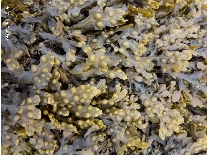 The aim of this investigation was to determine if there was a difference in height between Bladder Wracks in the middle shore of an exposed area and a sheltered area of the beach at Angle Point in Pembrokeshire, Wales. This was done, by measuring the longest length of the Bladder Wracks, within a 20×1.5m transect on both the exposed and sheltered side of the beach. A total of 216 samples were found and a t-test revealed that there was a significant statistical difference between the height of a Bladder Wrack and its exposure on the beach. I also further found that not only was there a difference between Bladder Wrack height, but also a difference in abundance at each site suggesting that there is a relationship between the seaweed heights and abundance of Bladder Wracks depending on exposure. This was due to multiple biotic and abiotic factors such as wave action and salinity.
The aim of this investigation was to determine if there was a difference in height between Bladder Wracks in the middle shore of an exposed area and a sheltered area of the beach at Angle Point in Pembrokeshire, Wales. This was done, by measuring the longest length of the Bladder Wracks, within a 20×1.5m transect on both the exposed and sheltered side of the beach. A total of 216 samples were found and a t-test revealed that there was a significant statistical difference between the height of a Bladder Wrack and its exposure on the beach. I also further found that not only was there a difference between Bladder Wrack height, but also a difference in abundance at each site suggesting that there is a relationship between the seaweed heights and abundance of Bladder Wracks depending on exposure. This was due to multiple biotic and abiotic factors such as wave action and salinity.
Introduction
Background Information
This investigation will focus on studying the species Fucus vesiculosus, commonly known as Bladder Wracks. They are classified: Domain: Eukaryotic; Kingdom: Chromista; Phylum: Heterokontophyta; Class: Phaeophyceae; Order: Fucales; Family: Fucaceae; Genus: Fucus; Species: Fucus vesiculosus. [1]
Figure 1: Fucus vesiculosus
The Bladder Wrack is one of the most prevalent species of algae in the North Atlantic Ocean. It is found in the more temperate waters with lower salinity. It provides food for a number of different organisms living near the northern Atlantic shore as well as nutrients for humans, which help people lose weight and cure the iodine deficiency, goiter. [2]
The fronds of the bladder wrack grow up to 90 cm long and 2.5 cm wide and have a prominent midrib throughout. The seaweed is identified by the spherical bladders, which are paired down either side of the mid-rib. These, however, may be absent in the juvenile bladder wracks. The margin is smooth and the frond is dichotomously branched.[3] The bladder wrack is most commonly attached to hard substrata pebbles, rocks, and dense seabeds for example. This connection is through a discoid holdfast, root like structure ensuring that the algae isn’t pulled out with strong waves and currents in the ocean.
The bladder wrack has evolved over time to find its ecological niche in the littoral zone, where the tide changes the depth of the water, and the sublittoral zone, where the organism is constantly submerged. An ecological niche is the role of an organism within its habitat. Being in the littoral zone can cause some problems for the bladder wracks. For example, when the water recedes at low tide, many organisms are left exposed to the heat of the sun and dry out. It has adapted to fulfil its niche in a number of ways, which will be discussed.
Bladder wrack reproduces by means of special receptacles that begin to develop on the plants sometime around December and which remain present until late summer. Peak fertility occurs in May and June, and eggs and sperm are released directly into the water column when the plants are submerged at high tide. Fertilisation is largely a matter of chance, so to increase the probability of successful reproduction large quantities of eggs and sperm are released. One plant may have more than 1000 reproductive receptacles containing more than 1,000,000 eggs.[4] These times of reproduction could have an affect on my findings and the length of the bladder wracks at the time of year. As this study is taking place during one of the reproduction periods in June, the bladder wracks will only just have reproduced and therefore will not have a high quantity of smaller young bladder wracks.
Fucus vesiculosus have a lot of morphological adaptation, which are beneficial to survival. The first adaptation, the holdfast is a root like structure, which ensures that an organism doesn’t get pulled away from the area it has evolved to thrive in. Next, the bladder wrack has evolved to be long thin and flat for a maximum amount of surface area to volume ratio. The extremely flat fronds allow it to absorb the maximum amount of sunlight needed for photosynthesis. The reason for the bladder wracks brown pigment (fucoxanthin) ensures a greater absorption of light, making photosynthesis more efficient. The brown colour of these algae results from the dominance of the xanthophyll pigment fucoxanthin, which masks the other pigments, Chlorophyll a and c (there is no Chlorophyll b), beta-carotene and other xanthophylls. The colours blue, with the longest wavelength, red and green on the spectra are mostly absorbed while the colour brown is reflected, therefore the brown colour of the algae.[5]
As I mentioned above, the bladders on the bladder wrack are another morphological adaptation. The bladders contain the product of photosynthesis, oxygen, allowing the seaweed to stay afloat when the tide comes back in, so that photosynthesis can proceed at a more productive rate. Oxygen in seaweed is produced in the same why as plants on land. During the light dependent reactions and phosphorylation in the chloroplasts, energy from light raises two electrons in each chlorophyll molecule to a higher energy level. Once these electrons left the chlorophyll molecules, they pass along the enzyme transport chain into the thylakoid membranes through a series of oxidation and reduction reactions in carrier proteins. The energy made in these redox reactions synthesizes ATP. Oxygen is produced in the bladder wrack when an enzyme catalyses the splitting of water in the thylakoid space. Some of this oxygen is also used in the respiration of the bladder wrack and increases growth and the length of the seaweed.[6]
The bladders are held together by white filaments, which break as the organism increases in age. Bladder wracks are producers at the bottom of the food chain so they have multiple predators, which they are adapted to overcome by producing and coating themselves in various compounds called phlorotannins.[7]
The brown algae gain nutrition through the process of photosynthesis where by sugars are produced. The green pigment, chlorophyll, captures the sun’s energy, converting light energy into chemical energy – glucose. Carbon dioxide and water are the only chemicals bladder wracks need to undergo photosynthesis. Bladder wracks mainly contain the pigment chlorophyll a, giving it its greenish brown colour.[8]
This algae is a dioecious organism which means the male and female gametes are on separate organism. Bladder wracks require water for reproduction where by the flagellated sperm eventually move toward the egg – this is broadcast spawning. The females produce nonspecific pheromones to attract the sperm in its direction. The algae only produce their gametes during summer and spring, in autumn and winter, the main focus of the bladder wracks is growth and development during the harsher conditions.[9]
Personal engagement
On February 15th, 1996 at 8 pm, the Sea Empress oil tanker ran aground just off the coast of Pembrokeshire in southwest wales.[10] Roughly 70,000 tons of North Sea light crude oil spilled out and it affected 120 miles of shoreline including some of UK’s most important and bio diverse coastal habitats. It affected hundreds of different species of algae, shells and birds, including the species of algae, which I am currently investigating.[11] I recently read an article on how the coastline has improved and recovered after the spill and therefore am really interested in researching this topic further myself. It is clearly evident from this oil spill that the environment around these algae has a great impact on their growth and reproduction, and just a slight change can affect their abundance majorly. Therefore when the environment of the water was completely contaminated it resulted in the death of a large percentage of the bladder wracks in this region. I want to see how other abiotic and environmental conditions like wave action affect both the height and abundance of the bladder wracks.
Aim
The aim is to determine if there is a statistically significant difference between the length of the Fucus Vesiculosus on sheltered shore and the length of the Fucus Vesiculosus on the exposed shore. The abiotic factors were taken into consideration from both areas to ensure whether or not they influenced the length of the bladder wracks.
Hypothesis
For my hypothesis, I am expecting data that will display that there is a difference in the length of bladder wracks in sheltered and exposed parts of the shore. The reason as to why the height – the height being from the ground to the longest frond – of the seaweeds will differ depending on the exposure is because in the areas of extreme exposure, the bladder wracks will not be able to overcome and survive the strong wave action which comes along with the prevailing wind. Where as on the sheltered side where there is less wave action, the bladder wracks are then less likely to die from being ripped out from the root and therefore there will be both a larger amount of bladder wracks on the sheltered side as well as a higher average height of the algae.
Method
Dependent variable: Length of Bladder Wracks (cm). This was measured with a meter ruler.
Independent variable: Position of seaweed on the beach – sheltered or exposed
Table 1: Control variables
| Control | Method of control | Reason for control |
| Time | The data was taken on the same day of the year in roughly the same time period so that the tide remained at low tide. | The length of the seaweed varies throughout the year with its life cycle and its growth. |
| Species of seaweed | Only the species of Fucus Vesiculosus was measured. | Different species of seaweeds are different sizes and in order for my investigation to be fair, it was essential to keep the species the same. |
| Meter ruler | The same meter ruler was used. | Different meter rulers may be different scales or may have varied accuracy. |
| Length of seaweed measured | The longest length of the seaweed was always measured. | If the measured length of the seaweed were not always the longest, my results would be very unreliable as the different leaves of the seaweed vary in length. |
| Shore height | The seaweed was only measured at one height on the shore – the mid shore (4.2m above chart datum) | If the seaweed were measured randomly or anywhere else, this would have a negative effect on my results. |
| Minimum amount of Bladder wracks measured | The minimum amount of bladder wracks measured was the same on the exposed shore as on the sheltered shore. | The minimum number of data points for the bladder wracks will be over 200 in order to give me a reliable mean. |
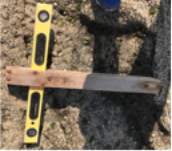 Equipment list
Equipment list
- Meter ruler (±0.01mm)
- ¼ m2 unstrung quadrat (error)
- Cross staff
- Pen, paper and clipboard with results table already drawn
- Tape measure (±1cm)
- Electronic thermometer (±0.1°C)
- Hygrometer (±1%)
Figure 6: Cross Staff
- Electronic anemometer (±0.1m/s)
- Lux meter (±2 lux)
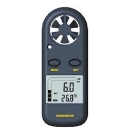
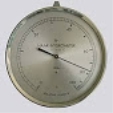
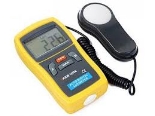
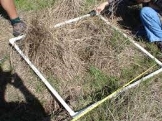
Figure 5: ¼-unstrung quadrat
Figure 1: Hygrometer
Figure 3: Lux meter
Figure 4: Electronic anemometer
Abiotic factors
I measured the abiotic factors to take them into consideration when reviewing my results. They cannot be controlled but they should be measured so any differences can be considered when analyzing the results.
| Abiotic Factors | How it affects results | How it will be measured |
| Temperature | A higher temperature results in faster rate of photosynthesis meaning that the algae will grow faster. | Electronic Thermometer (+0.1ºC) |
| Humidity | A more humid environment is more favorable because desiccation is less likely for the Bladder wracks. | Hygrometer (+1%) |
| Wind speed | An extremely high wind speed could result with some of the algae being ripped out from their roots. | Electronic Anemometer (+0.1m/s) |
| Light intensity | Light intensity affect the rate of photosynthesis of the algae meaning more food will be produced and the algae will grow taller. | Lux (+2 lux) |
Table 2: Abiotic factors, how they are measured and how they affect the results.
Study site
The study took place on Angle point in Pembrokeshire, Wales. This is a rocky beach with both a sheltered side and a semi exposed side, allowing various species of algae to grow and flourish. The Bladder Wracks were measured on the middle shore, 4.2m above sea level. The red lines on the pictures below show roughly the area that was sampled.
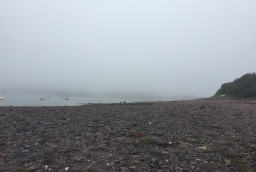
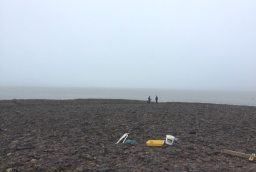
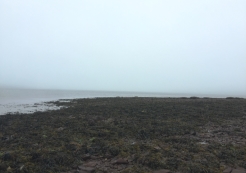
Semi exposed side of bay
Sheltered side of the bay
Angle Point


Trial study
Before I conducted my experiment, I performed a trial study in order check both my research question was answerable and my methodology was correct to ensure I could gather the correct data to determine my hypothesis.
During this trial study, I decided to place down a rope in the middle shore and measure all of the bladder wracks along this 10m transect. As there were so few bladder wracks along this transect, it meant that I couldn’t collect enough data points for the middle shore. In order for me to collect the amount of data points that I needed I would have had to repeat this placing of the transect over 20 times. Instead, I decided to create a wider transect by placing down two measuring tapes along a 20m stretch with 1.5m between the two tape measures creating 30m2 area in which I measured each bladder wrack until I had enough data points. In the trial study I planned to record the difference in bladder wrack length between the middle shore and the lower shore, however due to the fact that the tide wasn’t low enough during the 5 hours we were given to conduct our research, I ended up changing my research question. I compared the length of bladder wracks on two different parts of the beach with varying exposure, however, keeping the height of the beach the same.
Procedure
- Identify the exposed and sheltered part of the beach.
- Starting with the exposed side of the beach, use a 0.6m cross staff to find the middle shore of the beach at 4.2m above sea level. The cross level must be kept horizontal so that the spirit is level and the eyehole can be looked through to find the point on the rock 0.6m vertically above. A marker is placed there and the cross staff is moved to the marker and the process continues until the height of 4.2m is reached. In my experiment, the sea was at 2.35 according to the external tide data so roughly three cross staff measurements had to be made to reach 4.2m.
- Create a horizontal transect by placing two 20m tape measures parallel to the sea with 150cm between the two tapes at the middle shore of the exposed side of the beach.
- Using a metre ruler measure the longest length of 100 Bladder Wracks between this 20×1.5m transect.
- Record these results into the data table.
- Repeat points 2 to 5 on the sheltered section of the beach.
7. Measure the abiotic factors (temperature, light intensity and humidity) using an electronic thermometer, a lux meter and a hygrometer.
Reliability
In order to ensure that this experiment is reliable, I will collect 100 data points from both the exposed area of the beach and the sheltered area. This makes the investigation more reliable as the average deduced will be more repeatable due to the large amount of data points. Measuring the correct length of the longest frond of bladder wrack to the nearest centimetre will also had to the accuracy of this experiment.
Safety considerations
Safety precautions must be taken into consideration while conducting this experiment in order to minimise the risk of danger in this investigation.
| Hazard | Severity (1-5) | Likelihood
(1-5) |
Risk Score | Control Measures | Reduced likelihood | New risk score |
| Cut yourself on the rocks | 2 | 3 | 5 | Avoid the wet patches and wear sturdy shoes. | 2 | 4 |
| Slipping on algae | 3 | 4 | 8 | Wear appropriate footwear | 3 | 7 |
| Sunburn | 2 | 4 | 4 | Wear sun cream and a cap. | 1 | 2 |
Ethical considerations
During this experiment and whilst sampling the Bladder Wracks, some ethical considerations should be taken into consideration. This will ensure that the algae and various organisms are handled with respect and no damage is done to the surrounding environment and ecosystem.
- The roots and bases of the bladder wracks shouldn’t be ripped out; otherwise they will dry out and die. This would affect the ecosystem, as the algae are a vital source of oxygen and producer in the rock shore ecosystem.
- Don’t pop their bladders you don’t want urea all over you
- Do not pop the bladders on the bladder wrack, as these are an important adaptation, which ensure the algae remain close to the surface of the water where they can use light to photosynthesize and produce food.
Results
Quantitative Data
Table of Abiotic Factors at the exposed side at Angle point in Pembrokeshire, the sampling site
| Abiotic Factors | Measurement |
| Temperature | Ground temperature was 18.5ºC
Air temperature was 17ºC |
| Humidity | 97.5% |
| Wind speed | 4 m/s on average in 3 minutes |
| Light intensity | 0215 lux |
Table of Abiotic Factors at the sheltered side of Angle point in Pembrokeshire, the sampling site
| Abiotic Factors | Measurement |
| Temperature | Ground temperature was 19ºC
Air temperature was 17.5ºC |
| Humidity | 97% |
| Wind speed | 2 m/s on average in 3 minutes |
| Light intensity | 0217 lux |
Qualitative Data
I noticed that there was a higher abundance of bladder wracks in the sheltered area than in the exposed area. On the sheltered side of the beach I realized that they were found more in clumps on the sheltered side and more spread out on the exposed side of the beach. From sampling this data, I realized that bladder wracks are more generally found in the middle and lower shore of the beach and barely any on the upper shore.
Data Presentation
The bar graph below includes the average heights of the bladder wracks on the exposed area of the beach and on the sheltered area.
The graph below shows that the bladder wracks were generally longer in the sheltered area of Angle point bay with and average of 65 cm. The exposed areas, however, contained seaweeds with an average length of 20cm. This displays that there is a drastic difference between the growth of and length of seaweeds depending on wave action. From the graph above, it can be noticed that in the sheltered region there is a higher standard deviation in the data. This means that the data points for the sheltered seaweed had a higher variety and range from the mean, while for the exposed seaweed the data points were much closer to the mean.
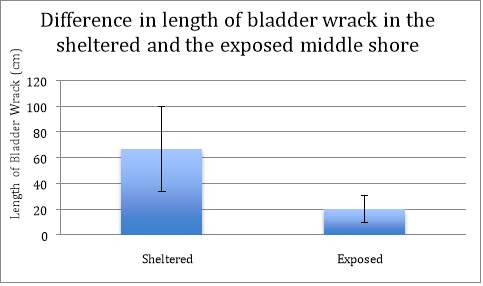
Statistical testing
This study looks into whether there is a difference between the length to the longest frond on a bladder wrack between a sheltered are of the beach and an exposed area. Due to the fact that two means of data from two different sites will be measured, a t-test should be calculated to determine whether the difference between the means is statistically significant.
Null hypothesis (H0): There will be no statistically significant difference between the length of the bladder wrack and the exposure of the shore.
Alternative hypothesis (Ha): There will be a statistically significant difference between the length of the bladder wrack and the exposure of the shore.
T-test
| T value: | 12.5 |
| Degree of Freedom: | 214 |
| Critical Value: | 1.96 |
| P value: | 0.000576 |
If the T value is higher than the critical value, then null hypothesis is rejected. As we can see from the t-test above, the T value of 12.5 is drastically higher than the critical value of 1.96. The tremendously small p value of 0.000576 is less than 0.05 so there is a >95% probability that the two data sets do vary. Therefore our alternative hypothesis is accepted and the null hypothesis is rejected.
Standard deviation
The standard deviation is a quantity expressing by how much the data points of a set of data differ from the mean value. The standard deviation value of the data from the exposed area of the beach was 10.48, representing a great variation and range in the data. The standard deviation of the sheltered area of the beach was even greater with 33.14. While I collected my data, I did realise the large variation in height and size of the bladder wracks along the exposed and sheltered area.
Conclusion
From my data one can conclude that there is a statistically significant difference between the length of seaweed and it’s position in an exposed or sheltered area of a beach. The mean length to the longest frond of the bladder wracks in the sheltered area of the bay was 66.85cm, whereas the average length in the exposed area was 19.72cm. Not only were the bladder wracks longer in the sheltered area, they were also more abundant. 33.14 is the standard deviation of the bladder wracks in the sheltered area, showing that the data points are spread over a wide range of values and therefore vary in size. This may be due to the abundance and larger range of bladder wracks in this area. Contrastingly, the standard deviation in the exposed area is 10.48 perhaps because of the smaller abundance of seaweed in this area. There is an absence of the longer bladder wracks presumably because they have been ripped off by the strong wave action. The standard deviations displayed an overlap in some of the data indicating that some bladder wracks were the same size on both the sheltered area and exposed area of the beach. Both averages, however, are far enough apart for there to be a statistically significant difference between the two size of the bladder wracks on the two sides of the beach. I know that I can trust the results from the t-test, which was performed on the data, obtaining >95% accuracy. On each side of the beach, 107 bladder wracks were measured to make the results fair and accurate.
The data, which I collected, prove my hypothesis to be correct. The main reason as to why the bladder wracks were, on average, found to be shorter on the exposed side of the beach, is the wave action. The strong wave action throughout the year, prevent the growth cycle of the bladder wracks by constantly ripping them out from the roots. Due to this reason, the bladder wracks are both shorter and less abundant on the exposed side of the shore. The lack of wave action on the sheltered side of the beach enforces a stable and perfect microhabitat for the bladder wracks to flourish, grow and reproduce, hence the larger abundance of them. In my opinion, the main reason for the extremely high standard deviation and range of size in the sheltered area is due to the fact that this environment is perfect for reproduction so there will be a larger range of age and therefore height in these sheltered waters. Another reason which could possibly explain the lack of growth in the exposed area of the beach, is because from the qualitative data that I collected, the alternative species of seaweed, such as the Ascophyllum nodosum, were extremely long perhaps blocking the sun from reaching the small bladder wracks at high tide and therefore preventing growth.
The Field Study Council has also investigated a similar question on how wave action affects the height of the bladder wracks. Their conclusion was inline with my findings. They argued that the greater the surface area the worse it becomes in wave action, as this will increase the chance of the weed being ripped off the rocks. On very sheltered shores you expect to see the density of bladders to be very high and the fronds will be long and broad. As wave action increases the density of bladders lessen, the frond gets shorter and narrower. Eventually, in extreme wave action the plants are small and bladderless. They also said that other factors may also come into play.
Other reasons affecting the size of these bladder wracks could be predation, light exposure and maybe salinity levels. In estuaries a lower salinity will influence thickness of fronds. An extension project could be to see how the abiotic factors on the two different sides of the beach may affect the height and growth of the bladder wracks.
Evaluation
It is evident that a couple of problems arose during my data collection and while analysing my investigation. Some of the limitations have been mentioned below, along with how it affected the data and how this limitation can be improved. I did try, however, to enforce as many control variables as possible to ensure the results had the least amount of bias and to have a valid experiment. Firstly, I made absolute sure that I was only measuring the one species of algae: the bladder wrack. Secondly, I ensured that I measured the bladder wracks on the same height above sea level: 3.25m, as the height above sea level is a main factor which affects the height of bladder wracks. For example, had I measured the bladder wracks at 6.25m above sea level, there may not have been enough bladder wracks present to measure and collect the sufficient amount of data. The next factor, which I controlled, was the transect area: 20m by 1.5m. If this factor wasn’t controlled it would have made the investigation inaccurate and unfair as the sample area would have varied in size. Time was another control factor. Although I couldn’t measure both sampling areas at exactly the same time, I measured the bladder wracks on the same day at the same point in the year. This is a crucial factor as the lengths of bladder wracks vary majorly through out the year so had I measured the two sampling spots at two different times of year, the data would not have been accurate at all or in fact functional. The exact timings of the measurements couldn’t really affect the results as the size and length of the algae doesn’t alter at all in such a short time span. The measurements of the bladder wracks were done to the nearest centimetre along with the same metre ruler, the degree of freedom being ±0.5cm. Human error may play a role with this however, as it was difficult to measure the slightly longer bladder wracks, which were over one metre, and also to work out which fronds were the longest ones.
One of the main problems was the human error in measurement of the bladder wracks. On the sheltered side, where the longer bladder wracks were measured, it was generally harder to measure the exact height of the bladder wrack. It was difficult to find the largest frond and hold up the extremely heavy algae. This perhaps led to over or under estimation affecting the accuracy of the data, therefore the t-test value and the standard deviation value may not have been as accurate. This same measurement problem also happened on the exposed side of the beach so with the 107 data points, in each area of the beach, this inaccuracy will not make too big of a difference. However, it could be improved by measuring each bladder wrack twice to find a more accurate measurement and by taking time with the measurement to make it as specific as possible. For the bladder wracks which are larger than the 1m ruler, either use two rulers or mark the metre spot and shift the ruler up to get the most accurate measurement.
Another slight limitation to my results was maintaining the 1.5m width of transect over the 20 metres. Across this 20 metre transect, I found it difficult to maintain the 1.5m in between, resulting in a larger or smaller sample. This resulted in reaching into different heights of the shore, affecting the validity of the data. This could have been improved by spending more time checking the distance between the two 20m transects. In the end however, if you put it into perspective, a bladder wrack measured 20cm further up or down from the set transect would not have been drastically different in height compared to the rest of the bladder wracks. So this intern didn’t really affect my data findings and investigation.
A defiant limitation of the data was the fact that it was only measured one time in the whole year. The problem is that at different times of the year the bladder wrack changes in size and height. This means that the data is incomparable with investigations done at different times of the year. The abiotic factors also change depending on the different seasons, perhaps also affecting the height of the seaweed. To improve on this limitation, the experiment could be repeated in each of the seasons to get a range of data from all the possible weather forecasts and abiotic factors to give a clearer understanding of how the bladder wrack height varies through out the whole year instead of just in the summer.
The height of the shore and the human error in placing down the tape measure transect at the right height is another problem that may or may not have affected the data. It was hard to find the exact height above sea level with the 0.6m cross staff as it was difficult to look through the eyepiece and place the marker exactly where the eyepiece showed it to be placed. This resulted in the height of the middle shore: 4.2m, not to be entirely accurate. This meant that transect on the sheltered side may have been a different height above sea level to the exposed side of the beach. Overall, however, I don’t think this had a huge affect on my results because in the end the underlying difference between the sheltered and exposed side of the beach can be seen. With more time, a more accurate measurement of the height above sea level could be taken. This could be done by researching the current height of the sea level at that exact time and then adding 0.6m to it for each cross staff measurement done.
Potential extension projects
If I had a chance to further my investigation, I would carry out a series of experiments that would build on and develop my current research question.
- I could do the exact same experiment with a different type of seaweed to see if it is just the bladder wracks, which grow taller in sheltered areas or in fact, all species of algae.
- It would also be interesting to see if there is a correlation between the size of the fronds and the amount of bladders present on it. This will perhaps depend on the wave action, as an increased number of bladders will increase the surface area and the risk of being ripped of on an exposed shore.
- I could repeat this experiment several times through out the year to get a scope of how the algae quantity size and even colour may change from season to season. The reason for this is to increase the validity of the experiment as the heights of algae change throughout the year depending on the reproductive seasons.
- I could mark the seaweed with numbers and then track their rate of growth from week to week or even month to month. This could also help measure their age and see the age difference of bladder wracks on the exposed vs. the sheltered shore.
- I could carry out this same experiment on different beaches and bays, which have both a sheltered and exposed area to see how these results differ depending on various abiotic and environmental factors.
- I could also measure the difference in height between exposed and sheltered parts of a beach on the lower shore as in this experiment, I only investigated the middle shore and there may be a difference in abundance between the mid and lower shores.
- Another developed investigation from this could be comparing the height of bladder wracks as you go up the beach. I could make a comparison between the height of the bladder wrack at high tide level, medium and low tide.
Bibliography
Wikipedia, the free encyclopaedia. Fucus vesiculosus. Available from: https://en.wikipedia.org/wiki/Fucus_vesiculosus [Web. 20 June 2018]
Ocean Biographic Information system. Available from: http://www.iobis.org/explore/#/taxon/444637 [Web. 27 June 2018]
White, N. 2008. Fucus vesiculosus Bladder wrack. In Tyler-Walters H. and Hiscock K. (eds) Marine Life Information Network: Biology and Sensitivity Key Information Reviews, [on-line]. Plymouth: Marine Biological Association of the United Kingdom. Available from: http://www.marlin.ac.uk/species/detail/1330 [Web. 27 June 2018]
Ireland’s Wildlife (2011), Bladder Wrack (Fucus vesiculosus). Available from: https://www.irelandswildlife.com/bladder-wrack-fucus-vesiculosus/ [Web. 20 June 2018]
Nicola White (2014). Encyclopaedia of Life: Fucus Vesiculosus. Available from: http://eol.org/pages/893114/details [Web. 28 June 2018]
Ben Harris (2011). Fucus vesiculosus, Bladderwrack. Available from: http://bioweb.uwlax.edu/bio203/2011/harris_benj/index.htm [Web. 24 July 2018]
The Naked Scientists (2010). Catching up with the Sea Empress Oil spill. Available from: https://www.thenakedscientists.com/articles/interviews/catching-sea-empress-oil-spill-0 [Web. 27 July 2018]
Wikipedia, the free encyclopaedia. Sea Empress Oil Spill. Available from: https://en.wikipedia.org/wiki/Sea_Empress_oil_spill [Web. 27 July 2018]
Field Study Council (2009) Questions and answers on the Rocky Shore. Available from: https://www.theseashore.org.uk/theseashore/questions and answers.html [Web. 27 July 2018]
Appendix
Raw Data
| Sheltered Middle Shore
Length of bladder wrack (cm) |
|
|
| 65 | 69 | 42 |
| 43 | 74 | 28 |
| 49 | 75 | 37 |
| 42 | 69 | 112 |
| 43 | 69 | 42 |
| 66 | 68 | 74 |
| 80 | 67 | 72 |
| 78 | 91 | 62 |
| 87 | 117 | 39 |
| 100 | 81 | 64 |
| 140 | 55 | 39 |
| 66 | 73 | 52 |
| 35 | 93 | 95 |
| 46 | 69 | 65 |
| 97 | 70 | 70 |
| 82 | 90 | 37 |
| 56 | 39 | 36 |
| 125 | 120 | 111 |
| 84 | 113 | 43 |
| 124 | 33 | 57 |
| 56 | 29 | 55 |
| 138 | 31 | 40 |
| 28 | 25 | 83 |
| 19 | 131 | 71 |
| 27 | 154 | 87 |
| 31 | 91 | 96 |
| 38 | 63 | 88 |
| 14 | 19 | 78 |
| 20 | 93 | 63 |
| 13 | 102 | 79 |
| 11 | 42 | 99 |
| 15 | 117 | 57 |
| 17 | 52 | 102 |
| 22 | 137 | 43 |
| 32 | 104 | 121 |
| 69 | 31 | |
| Exposed Middle Shore
Length of bladder wrack (cm) |
||
| 14 | 45 | 11 |
| 32 | 37 | 12 |
| 15 | 24 | 10 |
| 32 | 67 | 14 |
| 20 | 54 | 11 |
| 9 | 19 | 12 |
| 30 | 26 | 10 |
| 17 | 26 | 17 |
| 14 | 30 | 16 |
| 9 | 8 | 15 |
| 34 | 18 | 22 |
| 19 | 10 | 9 |
| 15 | 15 | 26 |
| 14 | 28 | 17 |
| 17 | 21 | 29 |
| 17 | 16 | 17 |
| 26 | 18 | 32 |
| 24 | 13 | 20 |
| 20 | 9 | 8 |
| 16 | 10 | 11 |
| 16 | 19 | 10 |
| 28 | 13 | 21 |
| 22 | 10 | 17 |
| 29 | 15 | 27 |
| 20 | 23 | 26 |
| 19 | 10 | 17 |
| 18 | 8 | 29 |
| 16 | 9 | 15 |
| 15 | 7 | 38 |
| 20 | 14 | 29 |
| 21 | 10 | 28 |
| 20 | 11 | 22 |
| 22 | 8 | 27 |
| 22 | 5 | 62 |
| 20 | 10 | 23 |
| 19 | 14 | |
[6] IB Biology Higher Level Textbook
Cite This Work
To export a reference to this article please select a referencing stye below:
Related Services
View allRelated Content
All TagsContent relating to: "Ecology"
Ecology is a field of biology that concentrates on the study of the relationships and interactions between living organisms (including humans) and their environments.
Related Articles
DMCA / Removal Request
If you are the original writer of this dissertation and no longer wish to have your work published on the UKDiss.com website then please:




